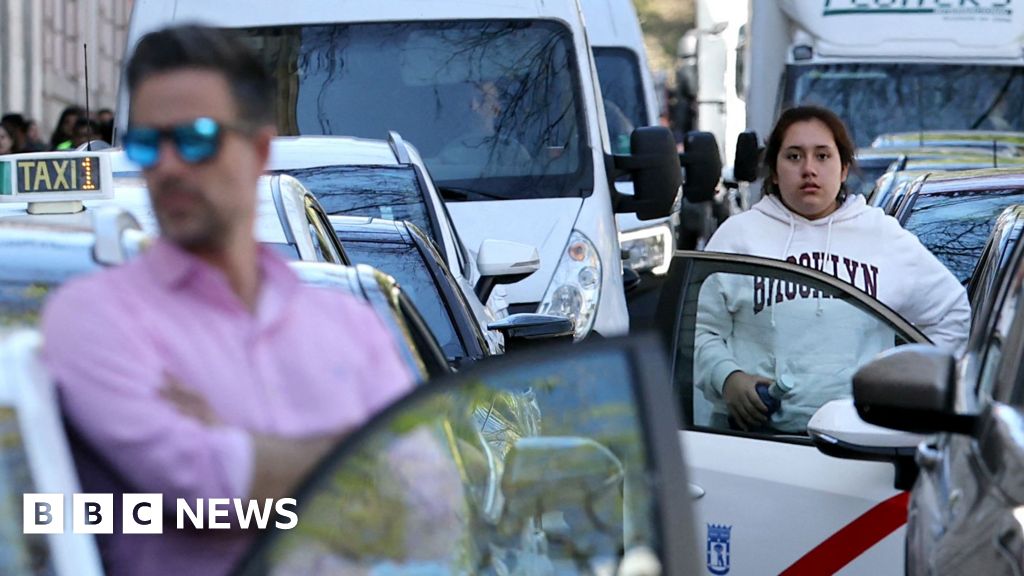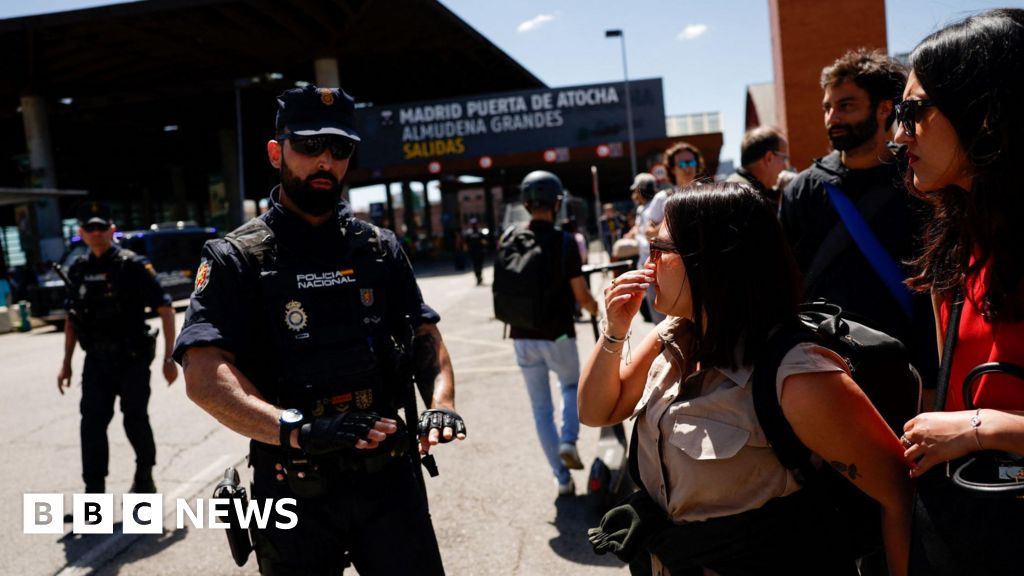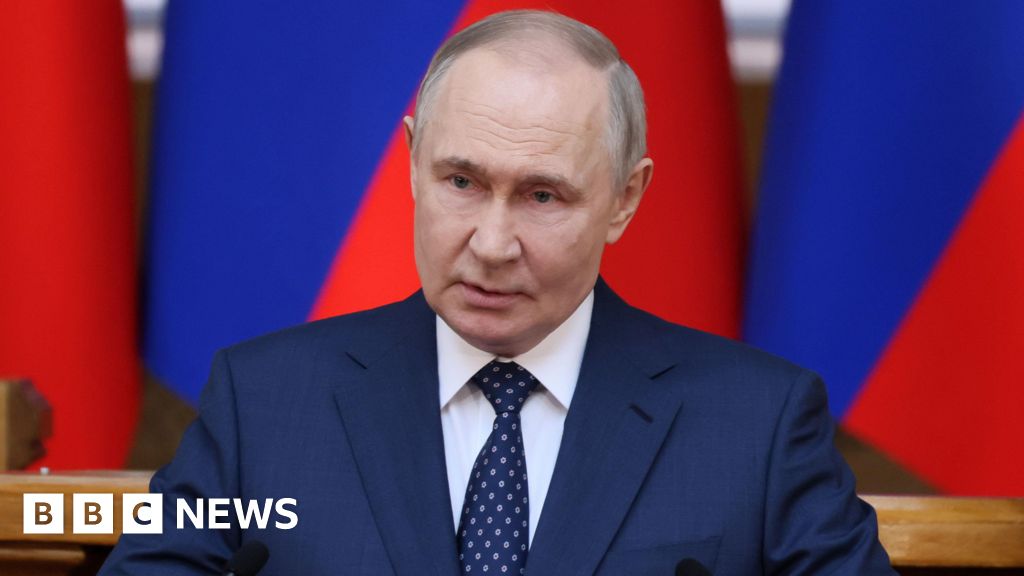ARTICLE AD BOX
By Megan Janetsky
Quibdó, Colombia
Bishop Barreto knows all the danger spots in the area
Juan Carlos Barreto peers up at a map of the dense jungles and rivers of Colombia's Chocó region.
Passing his hand along the map, he explains where armed groups plant landmines.
"All around there, they're forcibly confining communities," he says, explaining that militias set curfews and block residents from moving around freely.
"Here's where the left-wing guerrillas dominate, where the right-wing paramilitaries are gaining ground, and where urban gangs are making power grabs."
"All around, there's a fight for control," he concludes solemnly.
He sounds like an army commander preparing for battle, but Juan Carlos Barreto is no militia member like the ones that control the area. He is a bishop.
In Colombia's conflict zones, clergy like Bishop Barreto play a different role than ones in sleepy suburban communities.
On the front lines
They often work on the front lines of the most dangerous zones in Latin America. In remote areas like Chocó, they fill the voids left by the state, document the conflict, and use their role to pressure authorities and armed groups.
"We go where the local authorities don't," says Bishop Barreto.
The Atrato river serves as a highway in this area of dense jungle
With three in four people - including those who belong to armed groups - in Colombia describing themselves as Catholic, being a member of the clergy affords a measure of safety.
Members of armed groups may not have any moral qualms about threatening and killing people, but "in one sense they are really, really Catholic", explains Gimena Sánchez, Andes director for the think tank Washington Office on Latin America. And that is their respect for priests, Ms Sánchez says.
As a result, in zones where activists face constant violence, religious leaders like Bishop Barreto tend to enjoy a certain level of protection which allows them to travel to areas too dangerous for others to traverse.
"They speak to the groups and say 'give this kid back to his mother' or 'don't kill that person'," Ms Sánchez says. The priests tend to act as arbiters, "and the groups tended not to kill them, at least not on purpose".
You may want to read:
Historically, the Catholic Church in Latin America played a more traditional role, but there have been thousands of so-called "activist priests" who fight for the rights of rural and poorer populations, even pressuring the Catholic Church to confront its role in human rights abuses committed during the colonisation of Latin America.
During the most bloody years of General Pinochet 's military rule in Chile, the Church acted as one of the loudest voices of opposition and led efforts to search for people who had been forcibly disappeared.
In the 1970s and 80s, in El Salvador, Nicaragua and Guatemala, some priests took a leading role in pushing for radical change as these countries were embroiled in bitter civil wars or revolutions.
Susan Fitzpatrick Behrens, a historian at California State University, says that the the killing in 1989 of six Jesuit priests by the military in El Salvador "shocked the world" and drew attention to the crises in the region.
'I saw the soldiers who killed El Salvador's priests'
"As the communities they supported are violently repressed… church leaders gained this role as very articulate defenders of human rights," Prof Fitzpatrick Behrens says.
In one of the more extreme cases a priest, Camilo Torres even joined a left-wing guerrilla group in Colombia.
But the activism of some priests was not well viewed by the pope at the time, John Paul II. His clamp-down on their activities in turn spurred a backlash, with one priest quoted as saying in a 1980 Washington Post article that "the Pope has no clear notion of the realities of Latin America".
Drawn to activism
Sterlin Palacios says it was precisely this activism which drew him to the priesthood.
Father Palacios grew up in a small settlement along the Atrato River in Colombia, a waterway winding south hundreds of miles from the border with Panama.
Throughout his childhood, members of the church would often pass through his village and lend a hand to his community, providing the motivation for him to become a priest 24 years ago.
While the Atrato river is used by locals to move through the region by wooden canoe, armed groups use it to smuggle drugs.
Father Palacios joined the priesthood at a time of great conflict in Colombia and he soon found himself travelling the river to recover bodies from areas where armed groups banned others from going.
He would help people escape the clutches of armed groups and escort hundreds of villagers fleeing the violence which blighted the area.
Risky travel
"Being a part of the Catholic Church gives you a certain protection, but it's not absolute," Father Palacios says.
"Your life is always at risk, you are always a thorn in the side of these armed groups."
But he continues to visit to communities like the one he grew up in, documenting what is happening and raising the alarm about human rights abuses.
Julia Susana Mena, a leader of the Afro-Colombian organisation Cocomacia, says priests like Father Palacios are vital in helping her group access areas where there is conflict to verify what is happening.
The presence of priests helps groups like Cocomasia enter areas controlled by gangs
In October, Father Palacios and other priests travelled with human rights defenders like Ms Mena to check on communities who have been forcibly confined to their areas by the criminal group known as the Gulf Clan.
Father Palacios says their main task when they visit communities which have been threatened by armed groups is "to keep hope alive".
"The most important thing we've done in these regions is to ensure that life endures," he says. "That life is our main achievement."

 3 years ago
80
3 years ago
80








 English (US) ·
English (US) ·